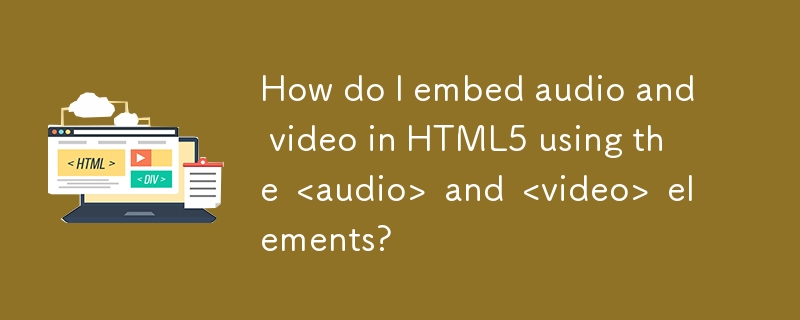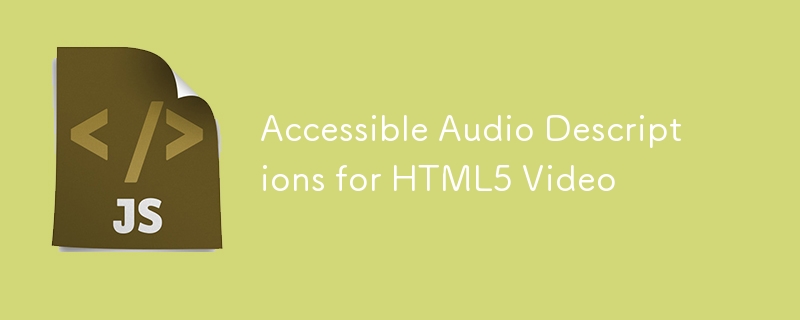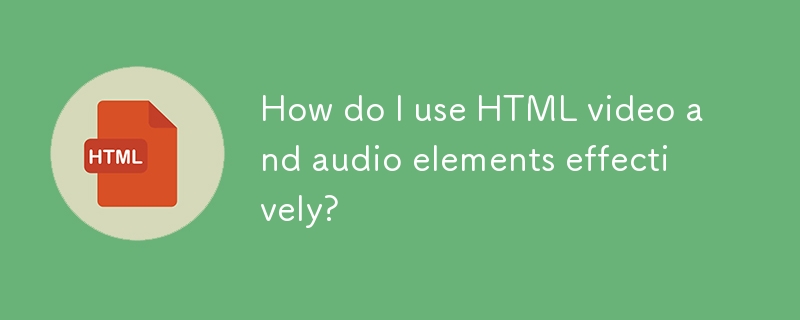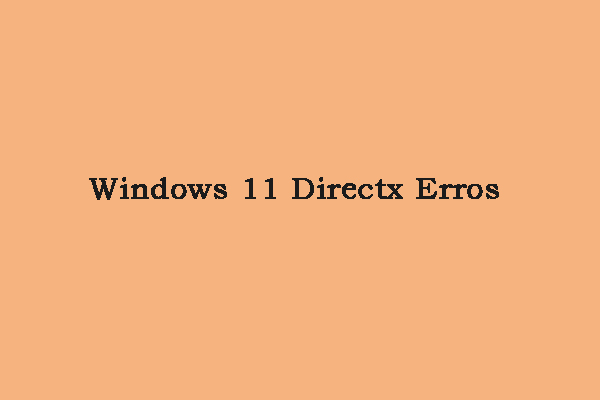Found a total of 10000 related content

HTML5 Video and Audio: The Markup - SitePoint
Article Introduction:Detailed explanation of HTML5 video and audio tags: Building a responsive video player
This article is excerpted from the book "HTML5 & CSS3 for the Real World, 2nd Edition" co-authored by Alexis Goldstein, Louis Lazaris and Estelle Weyl. This book is available in major bookstores around the world, and you can also purchase the e-book version here.
Core points
HTML5's video and audio tags allow for embedded video and audio elements directly in HTML code, without the need for external plug-ins or players.
HTML5 video and audio tags contain multiple attributes to control the behavior of these elements, such as autoplay
2025-02-18
comment 0
338


Essential Audio and Video Events for HTML5
Article Introduction:Detailed explanation of key events in HTML5 audio and video and analysis of browser differences
HTML5 and elements provide rich event mechanisms. Some events such as the "play" event are clear at a glance, while others, such as the "progress" event, are more complicated. This article will explore some of the most important media events in depth, analyzing their triggering timing, related attributes, and differences between different browsers.
Core points
HTML5 and elements provide a variety of events, some are simple and easy to understand (such as "play" events), and some are more complex (such as "progress" events).
Play events (such as "play", "pause", "ended") respond to media playback or pause operations and follow the corresponding media
2025-02-23
comment 0
444

Adding audio and video content to webpages using HTML5 tags.
Article Introduction:HTML5 provides convenient audio and video embedding functions without third-party plug-ins. 1. Use tags to directly play audio. It is recommended to provide MP3, WAV, and OGG formats to enhance compatibility; 2. When embedding videos with tags, it is recommended to select MP4 and WebM formats, and pay attention to the impact of file size on loading speed; 3. Automatic playback requires matching muted attributes to avoid being intercepted by the browser; 4. Preload can be used to control preload, poster settings for video covers and other optimization experiences. Following the above method ensures stable operation in modern browsers.
2025-07-03
comment 0
817

How to control HTML5 video and audio playback using JavaScript?
Article Introduction:To control HTML5 video and audio playback using JavaScript, master the following key operations to achieve basic control. 1. Start or pause play can be achieved through the .play() and .pause() methods, and it is recommended to trigger through user interaction to be compatible with mobile browsers; 2. Control the volume and set the value from 0 to 1 through the volume attribute, and switch by setting the muted attribute to true or false; 3. Jump to a specific time to play, you can use the currentTime attribute, which supports direct assignment or increase or decrease the current time, and it is recommended to add error handling; 4. Listen to the playback status changes can be achieved through events such as play, pause, ended and timeupdate.
2025-06-24
comment 0
733

10 Best jQuery and HTML5 Media Players
Article Introduction:Ten best jQuery and HTML5 video players tutorials
In the past, Flash videos were used on websites because Flash was almost the only option to play videos. But now everyone wants video playback support to be broader, with multiple audio and video formats, playlists, adjustable controls, automatic aspect ratio video and more… All of these features can be achieved by using jQuery plug-in and HTML5, and you can use audio and video in a simple way. Check out the ten best jQuery and HTML5 player tutorials we have compiled below! enjoy! Related articles:
10 Crazy HTML5 and JS Experiments Showcase
jQuery and the new HTML5 key points
jQuery
2025-02-27
comment 0
546

Audio and Video: HTML5 VS Youtube Embedding
Article Introduction:HTML5isbetterforcontrolandcustomization,whileYouTubeisbetterforeaseandperformance.1)HTML5allowsfortailoreduserexperiencesbutrequiresmanagingcodecsandcompatibility.2)YouTubeofferssimpleembeddingwithoptimizedperformancebutlimitscontroloverappearanceand
2025-06-19
comment 0
524

HTML5 Audio and Video: A Beginner's Guide
Article Introduction:HTML5'sapproachtomediaisspecialbecauseitintroducesnativesupportforaudioandvideo,eliminatingtheneedforthird-partyplugins.1)Useandtagstoembedmedia.2)CustomizemediaplayerswithJavaScriptandCSSforenhanceduserinteraction.3)Handledifferentbrowsersupportbypr
2025-06-20
comment 0
235

Accessible Audio Descriptions for HTML5 Video
Article Introduction:Summary of key points
Traditional visually impaired audio descriptions require professional video editing equipment to be encoded and embedded in separate audio tracks of video files. This process is often unrealistic for most content creators.
The HTML5 video specification provides an audioTracks object that theoretically allows the implementation of switch buttons for audio descriptions and controls the audio and video volumes separately. However, browsers currently have limited support for this feature.
Another solution is to use MediaController, a feature of HTML5 audio and video that allows syncing multiple sources. This feature is currently limited in browser support, but it can be used to launch two media simultaneously using existing, widely implemented features
2025-02-23
comment 0
1173

Build a Media Player with HTML
Article Introduction:The possibilities for media in HTML have taken off with the introduction of the video and audio elements in HTML5. Now we can embed video and audio in websites without the need for proprietary technologies like Flash or Silverlight.
With browser su
2025-02-20
comment 0
513

Streaming media efficiently using HTML5 video and audio.
Article Introduction:TostreammediaefficientlywithHTML5,usecompatibleformatslikeMP4andWebMforvideoandMP3orOGGforaudio.1)CompressfilesbeforeuploadingusingtoolslikeHandBrakeorAudacitytobalancequalityandsize.2)Usethepreloadattributewisely—autoforcriticalmedia,metadataotherwi
2025-07-02
comment 0
716

Mastering HTML5 Audio and Video: A Practical Guide
Article Introduction:HTML5audioandvideorevolutionizewebmultimediabyofferingnativesupportandadvancedfeatures.1)Theyeliminatetheneedforthird-partyplugins,enhancingeaseofuse.2)ProgrammaticcontrolviaJavaScriptallowsforcustominteractions.3)Cross-browsercompatibilityandperform
2025-06-25
comment 0
1025

How to Embed Audio and Video: HTML5 Tags and Attributes
Article Introduction:HTML5shouldbeusedformultimediabecauseitsimplifiesembedding,enhancesuserexperience,andimprovesperformanceandaccessibility.1)Useandtagsforembeddingmediawithcustomizationoptions.2)Enhanceuserengagementwithcustomcontrolsandresponsivedesign.3)Manageperfor
2025-06-19
comment 0
362

Embedding Audio and Video in HTML5: A Detailed Explanation
Article Introduction:ToembedaudioandvideoinHTML5effectively,usetheandtagswithmultiplesourceformatsforcross-browsercompatibility,implementstreamingandlazyloadingforperformance,andenhanceaccessibilitywithsubtitles.
2025-06-20
comment 0
295

How do I use HTML video and audio elements effectively?
Article Introduction:HTML5 video and audio elements enable embedding media without plugins. Key issues include optimizing playback, ensuring cross-browser compatibility, and enhancing functionality with tools like Video.js and Plyr.
2025-03-18
comment 0
403

Playing and controlling media using the HTML5 video and audio tags.
Article Introduction:HTML5 and tags simplify web media playback. 1. The basic usage includes using the src attribute to embed media and add controls; 2. Provide various formats through elements to ensure compatibility; 3. Use JavaScript to control playback, such as .play(), .pause() and event monitoring; 4. Custom controls need to hide the default interface and design styles and interactions by themselves; 5. The automatic playback requires matching the muted and playsinline attributes. These features allow developers to build flexible media experiences without relying on third-party libraries.
2025-07-02
comment 0
1018


HTML audio and video: Best tools
Article Introduction:When processing HTML audio and video, the commonly used tools and technologies by developers include: 1. The encoding tool FFmpeg is used to convert video formats; 2. The editing tools Adobe PremierePro and FinalCutPro are used for video, and Audacity is used for audio; 3. Optimize the formats Google's WebP and WebM, which are used to reduce file size; 4. The playback control library Video.js and Plyr is used to enhance playback functions. These tools and technologies help developers improve productivity and user experience.
2025-06-20
comment 0
943

Audio and Video : What about browser compatibility?
Article Introduction:Browser compatibility can ensure that audio and video content works properly in different browsers by using multiple formats and fallback strategies. 1. Use HTML5 audio and video tags and provide multiple format sources such as MP4 and OGG. 2. Consider automatic playback and mute strategies and follow the browser's policies. 3. Handle cross-domain resource sharing (CORS) issues. 4. Optimize performance and use adaptive bit rate streaming media technologies such as HLS.
2025-06-11
comment 0
880



















